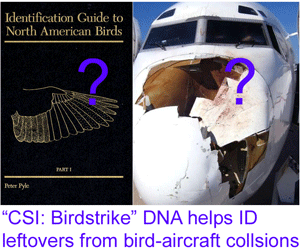Identifying the unidentifiable
 In July 2008 Wildlife Management researchers from Smithsonian Institution report on identifying otherwise unidentifiable remnants from bird-aircraft collisions (hereafter birdstrikes). Authors Dove et al point out “birdstrikes are a serious safety hazard and a major expense for the industry”. The US Federal Aviation Agency Wildlife Mitigation site shows about 600 incidents a month over the past year, peaking in late summer and early fall, presumably coincident with fall migration. The Smithsonian Institution has been identifying birdstrike species for military and civil aviation industries since the 1960s, analyzing specimens which range from whole carcasses to bits of feathers, tissue, or blood. Prior to availability DNA testing, identifications have relied on expert examination of detailed feather morphology with comparisons to Smithsonian’s vast bird specimen collection.
In July 2008 Wildlife Management researchers from Smithsonian Institution report on identifying otherwise unidentifiable remnants from bird-aircraft collisions (hereafter birdstrikes). Authors Dove et al point out “birdstrikes are a serious safety hazard and a major expense for the industry”. The US Federal Aviation Agency Wildlife Mitigation site shows about 600 incidents a month over the past year, peaking in late summer and early fall, presumably coincident with fall migration. The Smithsonian Institution has been identifying birdstrike species for military and civil aviation industries since the 1960s, analyzing specimens which range from whole carcasses to bits of feathers, tissue, or blood. Prior to availability DNA testing, identifications have relied on expert examination of detailed feather morphology with comparisons to Smithsonian’s vast bird specimen collection.
Of 1,715 birdstrike samples sent to Smithsonian Insitution during 4 months in fall 2006, 821(47.9%) contained only blood or tissue. Of these, 554 (67.5%) had amplifiable mtCOI DNA, and 535 (96.6%) with DNA led to species-level identifications based on reference sequences in Barcode of Life Database (BOLD). DNA barcoding identified 128 species representing 14 orders of birds, plus 2 bat species. 19 cases were deemed inconclusive as DNA barcode matched to a set of 2 or more closely-related species with overlapping barcodes, or the recovered sequence did not meet their 98% match criteria when compared to BOLD.
There was much better success recovering DNA from dry samples (70%) than from samples collected with a wet paper towel (about 23%), which had been the standard method, pointing the way toward improving yield of DNA-based ID. The authors conclude with a call for applying “a combination of morphological and molecular methods such as DNA barcoding for efficient, cost-effective birdstrike identifications”.
Just as in CSI television series, DNA-based identification can make possible what would otherwise be impossible; in this case, identifying birds from bits of tissue and blood and making birdstrike identifications available to those without access to Smithsonian’s experts or vast collections. In addition to helping airlines, birdstrike ID will inform our knowledge of bird migration routes. There are many exciting discoveries ahead.
This entry was posted on Sunday, July 13th, 2008 at 10:47 am and is filed under General. You can follow any responses to this entry through the RSS 2.0 feed. Both comments and pings are currently closed.
July 13th, 2008 at 7:19 pm
Why is it the wet paper towel samples have less chance recovering DNA ?
July 14th, 2008 at 8:37 am
In these cases, the biggest natural “degrader” of DNA (outside a living organism) is water – DNA will do OK if it is in a very dry environment, or frozen, or preserved in such a way that the degradation process is slowed considerably or stopped.
When a bird hits an airplane, the plane is moving very fast, and the drying process of any remains is pretty quick, therefore the DNA is usually OK to work with (an extreme case: we’ve successfully isolated high quality DNA from the inside of the engines after a strike – temperatures are VERY high, therefore the tissues and DNA dry instantly, and the DNA is in very good condition). A wet paper towel, while making the windscreen or wing easier to clean off, will provide conditions that will degrade the DNA much quicker. One of the things we’re evaluating is better methods to collect specimens to minimize degradation, thereby optimize probability of success.